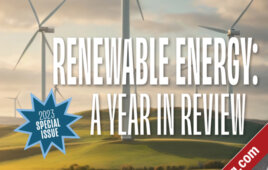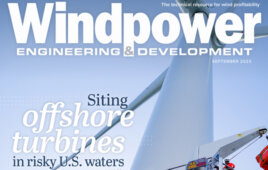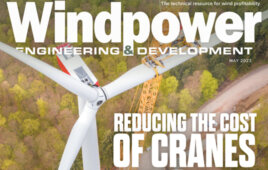How EVs will drive the wind industry and vice versa
The automobile, long the symbol of go-anywhere freedom, not long ago became an object of scorn because of its high consumption of fossil fuel. Is it possible to redeem vehicles from such disrepute by substituting electric drives for internal combustion engines?
Yes, it is. The great thing about this transformation from gas and diesel to electric is that renewable energy – ideally from wind-generated power –makes every nation a master of its own fate by eliminating dependence on hostile foreign nations for fuel.
While the evolution from fossil fuel to electric is just getting started, a recent announcement suggests that the transformation will come more quickly than anticipated. The event was Elon Musk’s unveiling of an over-the-road, long- distance heavy hauling truck — one that would usher in a new kind of 18-wheeler.
You may think Musk is as much a showman as a technician and visionary, and you are probably right, but he demands attention and rarely disappoints in public appearances. You can watch his truck’s introduction on YouTube. As it drove on stage, the crowd gasped in awe because of its size and distinct appearance. The specs for the rig were equally impressive. The tractor will pull an 80,000-lb rig, the legal max for tractor and loaded trailer. It will also be capable of, for reasons unknown, 0 to 60 mph in five seconds (presumably without the trailer) and when driven in the real world, a 500-mile range.
The size of the battery was not mentioned but a blog estimated it as 1,200-kWh. That is 12 times the size of the battery in a Tesla Model S sedan. A more scientific calculation is available at https://battery.real.engineering. The spreadsheet’s author lets readers plug in figures to find the battery weight and a kilowatt-hour rating. The point is that with today’s electric technology, the truck looks like a viable option to a diesel-powered rig. Trucking companies that see the rig as a way to cut costs will drive demand for more electric power, and (I have to say it) more wind-generated power. Transport firms will make operating large-battery EVs more than a trendy feel-good exercise.
Tesla is not alone. Other electric trucks with less flamboyant marketers include the Thor Class 8, Cummins Aeos Class 7, and Nikola Motors’ hydrogen-fuel cell vehicle. The Nikola is a more interesting variation because its hydrogen will be generated by electrolysis using wind-generated power. It also has other advantages, such as a greater range and shorter re ll times. Presumably, it will take only a few minutes for a hydrogen refill instead of an hour or more to recharge an electric truck.

Editor Paul Dvorak
Shortly after the Tesla truck debut, a truck mechanic on YouTube suggested that the writing was on the wall for him. It was clear he thought his job and career will soon be over. The mechanic’s despair, however, is a little premature. All the vehicles mentioned will require assembly, maintenance, and drivers. One rule of thumb applied to automation also applies to disruptive technology: For every job eliminated, two more are created elsewhere. What’s more, the transportation transformation from fossil fuel to electricity will require at least 20 years. The budding EV industry will need more power, and getting it from a home-grown wind industry seems a no-brainer. Like the wind industry, the electric-vehicle industry is brand new and can only get bigger and better.
Filed Under: Digital issues




